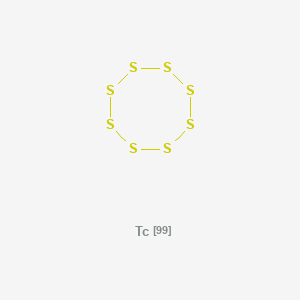



1. Colloid, Tc-99m Sulfur
2. Colloid, Technetium Sulfur
3. Lymphoszint
4. Tc 99m Sulfur Colloid
5. Tc-99m Sulfur Colloid
6. Technetium Sulfur Colloid
1. Technetium Tc-99m Sulfur Colloid
2. Tc99m-sulfur Colloid
3. Technetium Tc 99m Tsc
4. 99mtc-labeled Sulfur Colloid
5. Technetium 99m Sulfur Colloid
6. 556q0p6pb1
7. Technetium (99mtc) Sulfur Colloid
8. Db09397
9. Technetium Tc 99m Sulfur Colloid [usan]
10. Technetium Tc 99m Sulfur Colloid [who-dd]
11. Q27261285
12. Technetium Tc 99m Sulfur Colloid [usp Impurity]
13. Technetium Tc-99m Sulfur Colloid [orange Book]
| Molecular Weight | 355.4 g/mol |
|---|---|
| Molecular Formula | S8Tc |
| Hydrogen Bond Donor Count | 0 |
| Hydrogen Bond Acceptor Count | 8 |
| Rotatable Bond Count | 0 |
| Exact Mass | 354.682819 g/mol |
| Monoisotopic Mass | 354.682819 g/mol |
| Topological Polar Surface Area | 202 Ų |
| Heavy Atom Count | 9 |
| Formal Charge | 0 |
| Complexity | 24 |
| Isotope Atom Count | 1 |
| Defined Atom Stereocenter Count | 0 |
| Undefined Atom Stereocenter Count | 0 |
| Defined Bond Stereocenter Count | 0 |
| Undefined Bond Stereocenter Count | 0 |
| Covalently Bonded Unit Count | 2 |
Technetium 99m sulfur colloid is indicated as a diagnostic agent in adults for the following tests: localization of lymph nodes draining a primary tumor in patients with breast cancer or malignant melanoma; and evaluation of peritoneo-venous (LeVeen) shunt patency. It is indicated in both adult and pediatric patients for: imaging areas of functioning reticuloendothelial cells in the liver, spleen and bone marrow; and studies of esophageal transit and gastroesophageal reflux, and detection of pulmonary aspiration of gastric contents.
FDA Label
Radiopharmaceuticals
Compounds that are used in medicine as sources of radiation for radiotherapy and for diagnostic purposes. They have numerous uses in research and industry. (Martindale, The Extra Pharmacopoeia, 30th ed, p1161) (See all compounds classified as Radiopharmaceuticals.)
V - Various
V09 - Diagnostic radiopharmaceuticals
V09D - Hepatic and reticulo endothelial system
V09DB - Technetium (99mtc), particles and colloids
V09DB05 - Technetium (99mTc) sulfur colloid
Absorption
When administered subcutaneously, Technetium Tc 99m Sulfur Colloid enters the lymphatic capillaries and is transported with lymph to lymph nodes where it can be used to detect drainage of primary tumours. When administered by intraperitoneal injection, Technetium Tc 99m Sulfur Colloid mixes with the peritoneal fluid where the rate of clearance from the cavity allows assessment of shunt patency. When administered by intravenous injection, Technetium Tc 99m Sulfur Colloid is taken up by the reticuloendothelial system (RES), allowing RES rich structures to be imaged. Uptake of the radioactive colloid by organs of the RES is dependent upon both their relative blood flow rates and the functional capacity of the phagocytic cells. When administered orally, Technetium Tc 99m sulfur colloid can be used in esophageal transit studies, gastroesophageal reflux scintigraphy, and for the detection of pulmonary aspiration of gastric contents. This is possible as the active substance is not absorbed from the GI tract.
Route of Elimination
Following oral ingestion, elimination is primarily through the feces.
Volume of Distribution
Following oral ingestion, Technetium Tc 99m Sulfur Colloid is distributed primarily through the gastrointestinal tract.
In the average patient 80 to 90% of the injected collodial particles are phagocytized by the Kupffer cells of the liver, 5 to 10% by the spleen and the balance by the bone marrow.
Technetium Tc 99m decays by isomeric transition with a physical half-life of 6.02 hours. Following intravenous administration, Technetium Tc 99m Sulfur Colloid Injection is rapidly cleared from the blood by the reticuloendothelial system with a nominal half-life of approximately 2 1/2 minutes.
Following injection or oral administration, single photon emission computer tomography (SPECT) imaging is performed using a gamma camera to detect technetium-99m decay. This is possible as Technetium-99m decays by isomeric transition to technetium-99 through the release of a gamma ray.